Accounting Principles: Functions, Budgeting, and Financial Analysis
VerifiedAdded on 2023/06/10
|26
|6995
|462
Report
AI Summary
This report discusses accounting principles, which are rules and guidelines followed by organizations when presenting financial data. It covers the purposes and functions of accounting within regulatory and ethical constraints, along with the benefits and limitations of budgeting and budgetary planning. It includes the preparation of a cash budget and the creation of financial statements for sole proprietorships, partnerships, and non-profit organizations. Furthermore, it involves calculating important financial ratios and comparing an organization's performance over time using these ratios. The report also identifies various career opportunities in accounting, such as financial accountant, forensic accountant, management accountant, tax accountant, and project accountant, highlighting the skills required for these positions, including analytical skills, problem-solving abilities, integrity, numerical skills, negotiation skills, and customer service.
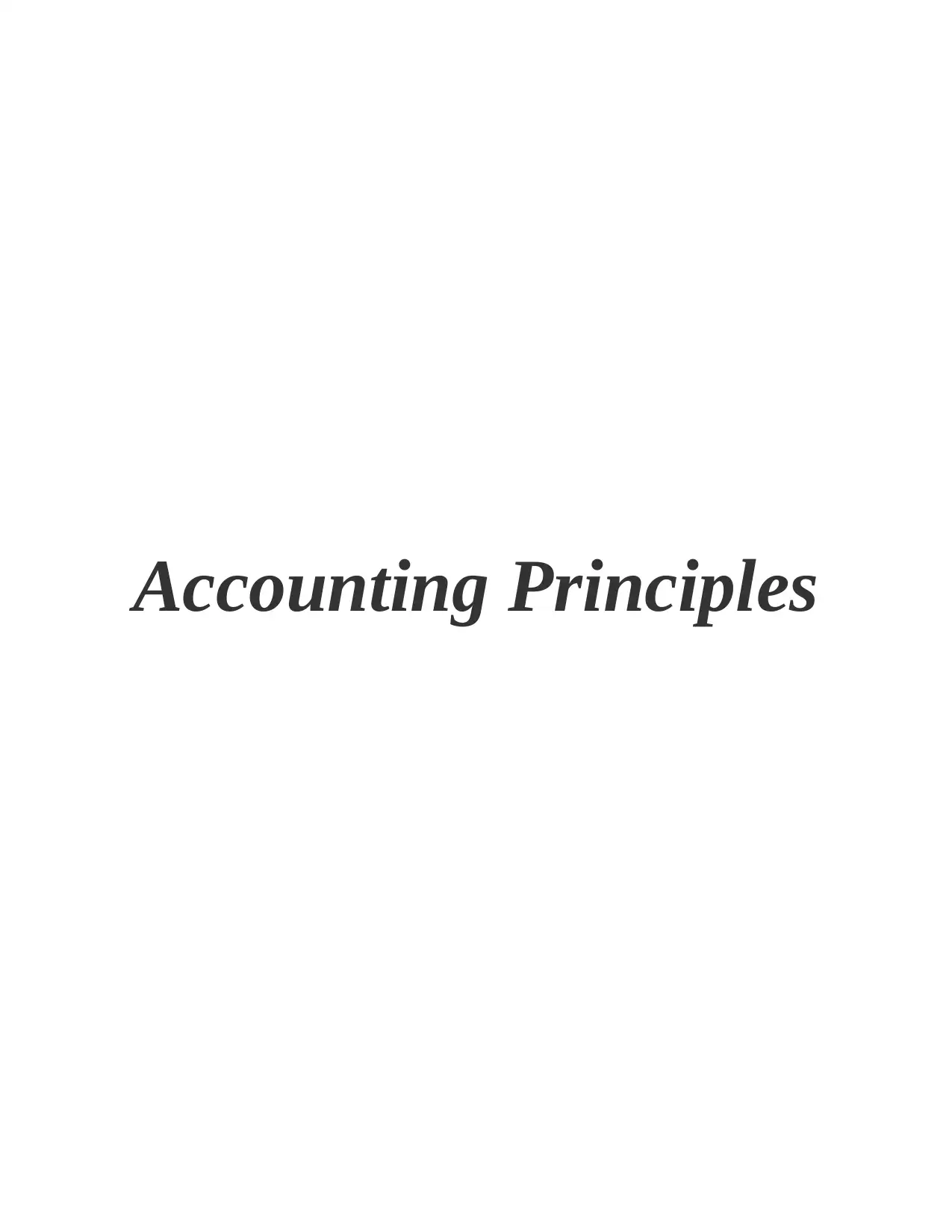
Accounting Principles
Paraphrase This Document
Need a fresh take? Get an instant paraphrase of this document with our AI Paraphraser
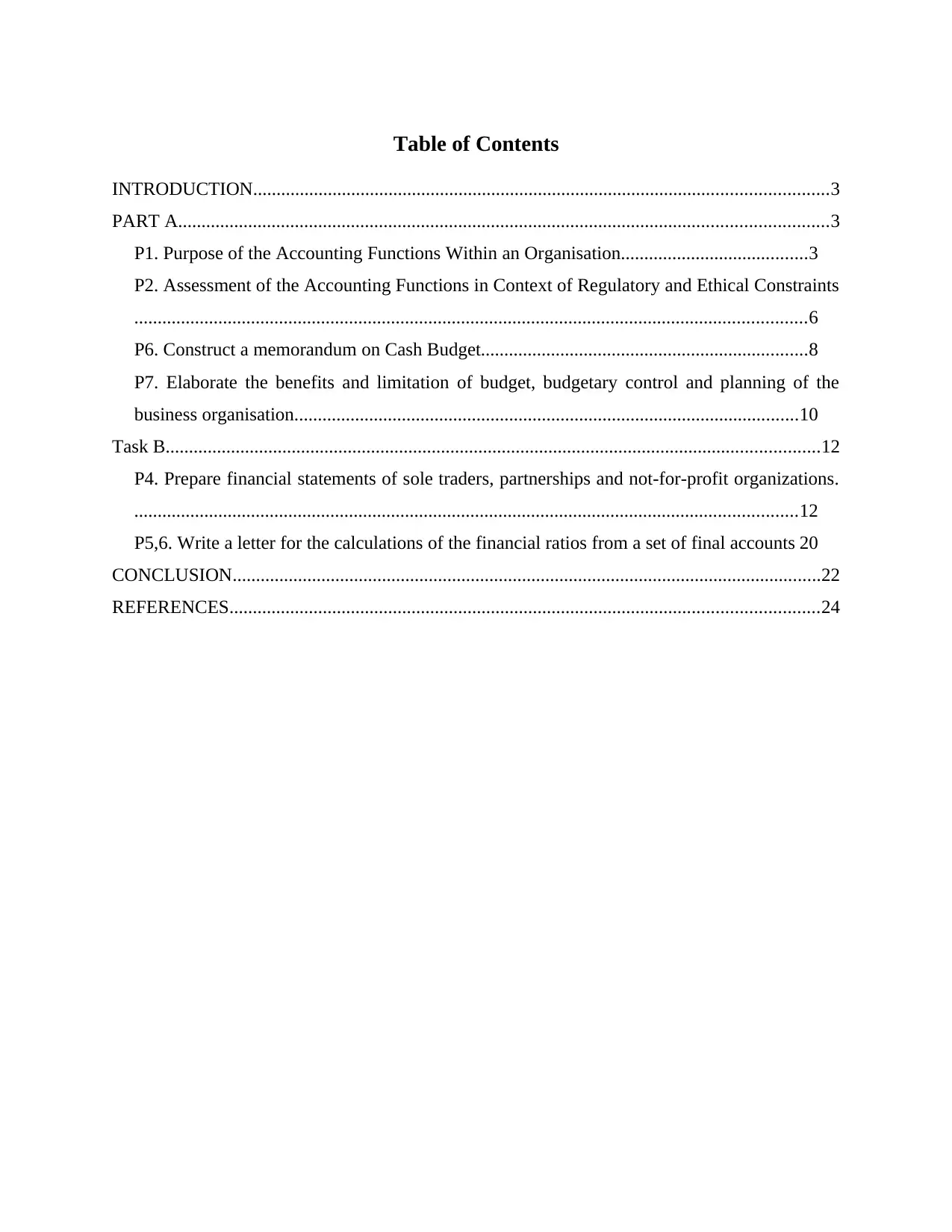
Table of Contents
INTRODUCTION...........................................................................................................................3
PART A...........................................................................................................................................3
P1. Purpose of the Accounting Functions Within an Organisation........................................3
P2. Assessment of the Accounting Functions in Context of Regulatory and Ethical Constraints
................................................................................................................................................6
P6. Construct a memorandum on Cash Budget......................................................................8
P7. Elaborate the benefits and limitation of budget, budgetary control and planning of the
business organisation............................................................................................................10
Task B............................................................................................................................................12
P4. Prepare financial statements of sole traders, partnerships and not-for-profit organizations.
..............................................................................................................................................12
P5,6. Write a letter for the calculations of the financial ratios from a set of final accounts 20
CONCLUSION..............................................................................................................................22
REFERENCES..............................................................................................................................24
INTRODUCTION...........................................................................................................................3
PART A...........................................................................................................................................3
P1. Purpose of the Accounting Functions Within an Organisation........................................3
P2. Assessment of the Accounting Functions in Context of Regulatory and Ethical Constraints
................................................................................................................................................6
P6. Construct a memorandum on Cash Budget......................................................................8
P7. Elaborate the benefits and limitation of budget, budgetary control and planning of the
business organisation............................................................................................................10
Task B............................................................................................................................................12
P4. Prepare financial statements of sole traders, partnerships and not-for-profit organizations.
..............................................................................................................................................12
P5,6. Write a letter for the calculations of the financial ratios from a set of final accounts 20
CONCLUSION..............................................................................................................................22
REFERENCES..............................................................................................................................24
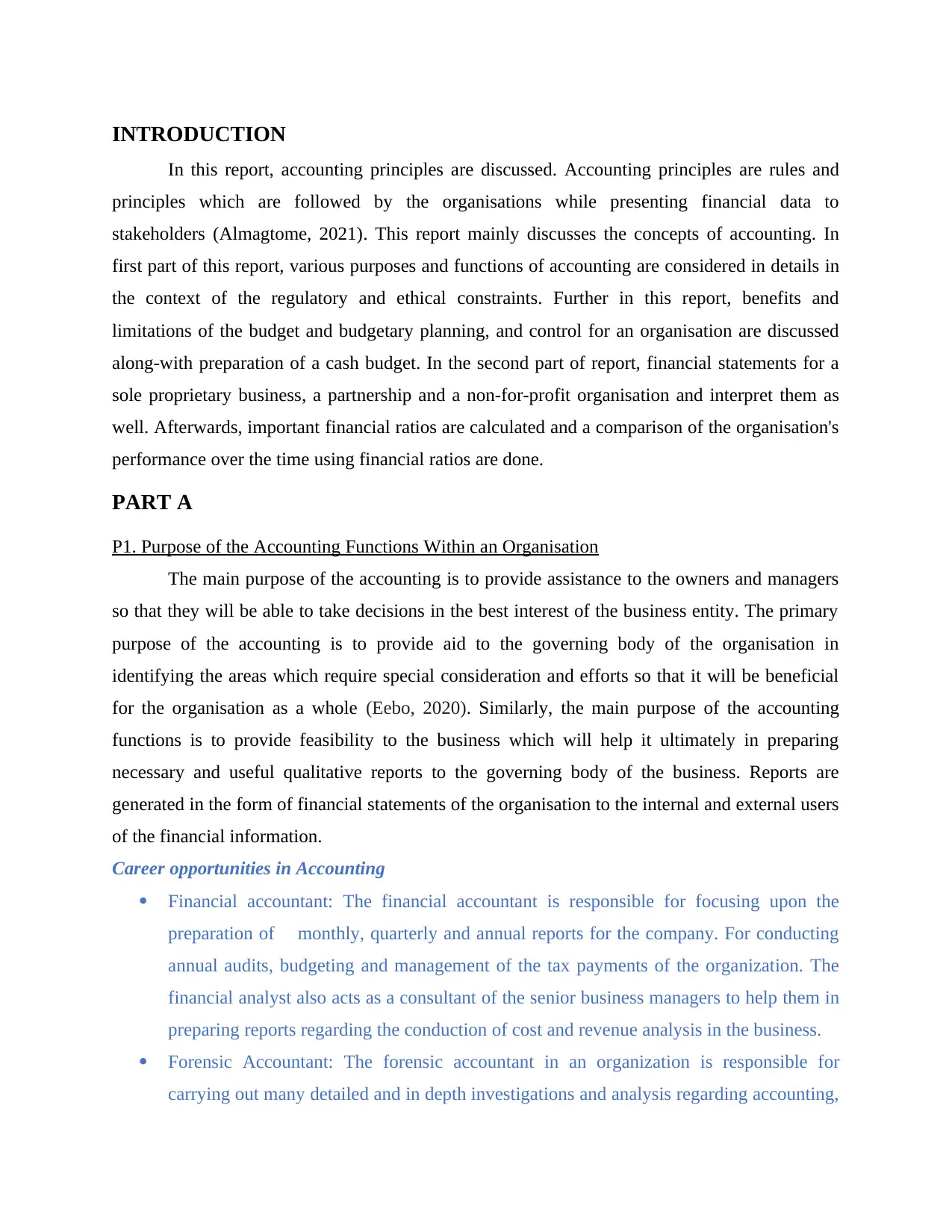
INTRODUCTION
In this report, accounting principles are discussed. Accounting principles are rules and
principles which are followed by the organisations while presenting financial data to
stakeholders (Almagtome, 2021). This report mainly discusses the concepts of accounting. In
first part of this report, various purposes and functions of accounting are considered in details in
the context of the regulatory and ethical constraints. Further in this report, benefits and
limitations of the budget and budgetary planning, and control for an organisation are discussed
along-with preparation of a cash budget. In the second part of report, financial statements for a
sole proprietary business, a partnership and a non-for-profit organisation and interpret them as
well. Afterwards, important financial ratios are calculated and a comparison of the organisation's
performance over the time using financial ratios are done.
PART A
P1. Purpose of the Accounting Functions Within an Organisation
The main purpose of the accounting is to provide assistance to the owners and managers
so that they will be able to take decisions in the best interest of the business entity. The primary
purpose of the accounting is to provide aid to the governing body of the organisation in
identifying the areas which require special consideration and efforts so that it will be beneficial
for the organisation as a whole (Eebo, 2020). Similarly, the main purpose of the accounting
functions is to provide feasibility to the business which will help it ultimately in preparing
necessary and useful qualitative reports to the governing body of the business. Reports are
generated in the form of financial statements of the organisation to the internal and external users
of the financial information.
Career opportunities in Accounting
Financial accountant: The financial accountant is responsible for focusing upon the
preparation of monthly, quarterly and annual reports for the company. For conducting
annual audits, budgeting and management of the tax payments of the organization. The
financial analyst also acts as a consultant of the senior business managers to help them in
preparing reports regarding the conduction of cost and revenue analysis in the business.
Forensic Accountant: The forensic accountant in an organization is responsible for
carrying out many detailed and in depth investigations and analysis regarding accounting,
In this report, accounting principles are discussed. Accounting principles are rules and
principles which are followed by the organisations while presenting financial data to
stakeholders (Almagtome, 2021). This report mainly discusses the concepts of accounting. In
first part of this report, various purposes and functions of accounting are considered in details in
the context of the regulatory and ethical constraints. Further in this report, benefits and
limitations of the budget and budgetary planning, and control for an organisation are discussed
along-with preparation of a cash budget. In the second part of report, financial statements for a
sole proprietary business, a partnership and a non-for-profit organisation and interpret them as
well. Afterwards, important financial ratios are calculated and a comparison of the organisation's
performance over the time using financial ratios are done.
PART A
P1. Purpose of the Accounting Functions Within an Organisation
The main purpose of the accounting is to provide assistance to the owners and managers
so that they will be able to take decisions in the best interest of the business entity. The primary
purpose of the accounting is to provide aid to the governing body of the organisation in
identifying the areas which require special consideration and efforts so that it will be beneficial
for the organisation as a whole (Eebo, 2020). Similarly, the main purpose of the accounting
functions is to provide feasibility to the business which will help it ultimately in preparing
necessary and useful qualitative reports to the governing body of the business. Reports are
generated in the form of financial statements of the organisation to the internal and external users
of the financial information.
Career opportunities in Accounting
Financial accountant: The financial accountant is responsible for focusing upon the
preparation of monthly, quarterly and annual reports for the company. For conducting
annual audits, budgeting and management of the tax payments of the organization. The
financial analyst also acts as a consultant of the senior business managers to help them in
preparing reports regarding the conduction of cost and revenue analysis in the business.
Forensic Accountant: The forensic accountant in an organization is responsible for
carrying out many detailed and in depth investigations and analysis regarding accounting,
⊘ This is a preview!⊘
Do you want full access?
Subscribe today to unlock all pages.

Trusted by 1+ million students worldwide

auditing activities in the business. The investigations relate to the finding regarding the
irregularities which are present in company's financial documents, reports and books
maintained. It also includes checking upon the losses that the company incurred and also
to recover all the unlawful or illicit finds that the company has (Kovtun, Kopytina and
Pavlyuchenko, 2018).
Management Accountant: The responsibilities of a management accountant involve
presenting the financial reports of the organization to all the senior managers in the
company to give them an overview and an insight of the financial performance and
situation of the company. The skills such as analytical and problem solving abilities help
them in managing the financial health and assist the senior business managers to plan,
strategize and make informed, correct decisions.
Tax Accountant: the tax accountant in an organization is solely responsible for
maintaining all tax-related obligations and duties of the company. It includes preparing
tax provisions schedules, returns, reports and maintain the database of the organization.
Finding the errors and mistakes committed while in the preparation of the company's tax
filings is also to be evaluated and checked by the tax accountant of the company.
Project Accountant: the responsibilities of a project accountant include managing the
operating budget of the company and to forecast and predict upon the process involved in
the projects. It also includes reviewing and analyzing the performance and of the project
to measure its success rate with the company management and stakeholders of the
enterprise.
Skills required for a position in accounting and finance:
Analytical skills: The analytical skills involve the quality of an individual to analyze data
sets, make critical decisions for an organization in terms of its accounting related issues,
solve for the complex and difficult problem situations in the business so that to provide
for taking in all the necessary information and data relating to the company and mentally
process and analyze the same data in order to assess and determine solutions necessary
for the respective problems (Mulawarman and Kamayanti, 2018).
Problem Solving: This skill helps accountant in an organization to understand and
interpret the business problems in order to provide for the suitable and reasonable
irregularities which are present in company's financial documents, reports and books
maintained. It also includes checking upon the losses that the company incurred and also
to recover all the unlawful or illicit finds that the company has (Kovtun, Kopytina and
Pavlyuchenko, 2018).
Management Accountant: The responsibilities of a management accountant involve
presenting the financial reports of the organization to all the senior managers in the
company to give them an overview and an insight of the financial performance and
situation of the company. The skills such as analytical and problem solving abilities help
them in managing the financial health and assist the senior business managers to plan,
strategize and make informed, correct decisions.
Tax Accountant: the tax accountant in an organization is solely responsible for
maintaining all tax-related obligations and duties of the company. It includes preparing
tax provisions schedules, returns, reports and maintain the database of the organization.
Finding the errors and mistakes committed while in the preparation of the company's tax
filings is also to be evaluated and checked by the tax accountant of the company.
Project Accountant: the responsibilities of a project accountant include managing the
operating budget of the company and to forecast and predict upon the process involved in
the projects. It also includes reviewing and analyzing the performance and of the project
to measure its success rate with the company management and stakeholders of the
enterprise.
Skills required for a position in accounting and finance:
Analytical skills: The analytical skills involve the quality of an individual to analyze data
sets, make critical decisions for an organization in terms of its accounting related issues,
solve for the complex and difficult problem situations in the business so that to provide
for taking in all the necessary information and data relating to the company and mentally
process and analyze the same data in order to assess and determine solutions necessary
for the respective problems (Mulawarman and Kamayanti, 2018).
Problem Solving: This skill helps accountant in an organization to understand and
interpret the business problems in order to provide for the suitable and reasonable
Paraphrase This Document
Need a fresh take? Get an instant paraphrase of this document with our AI Paraphraser
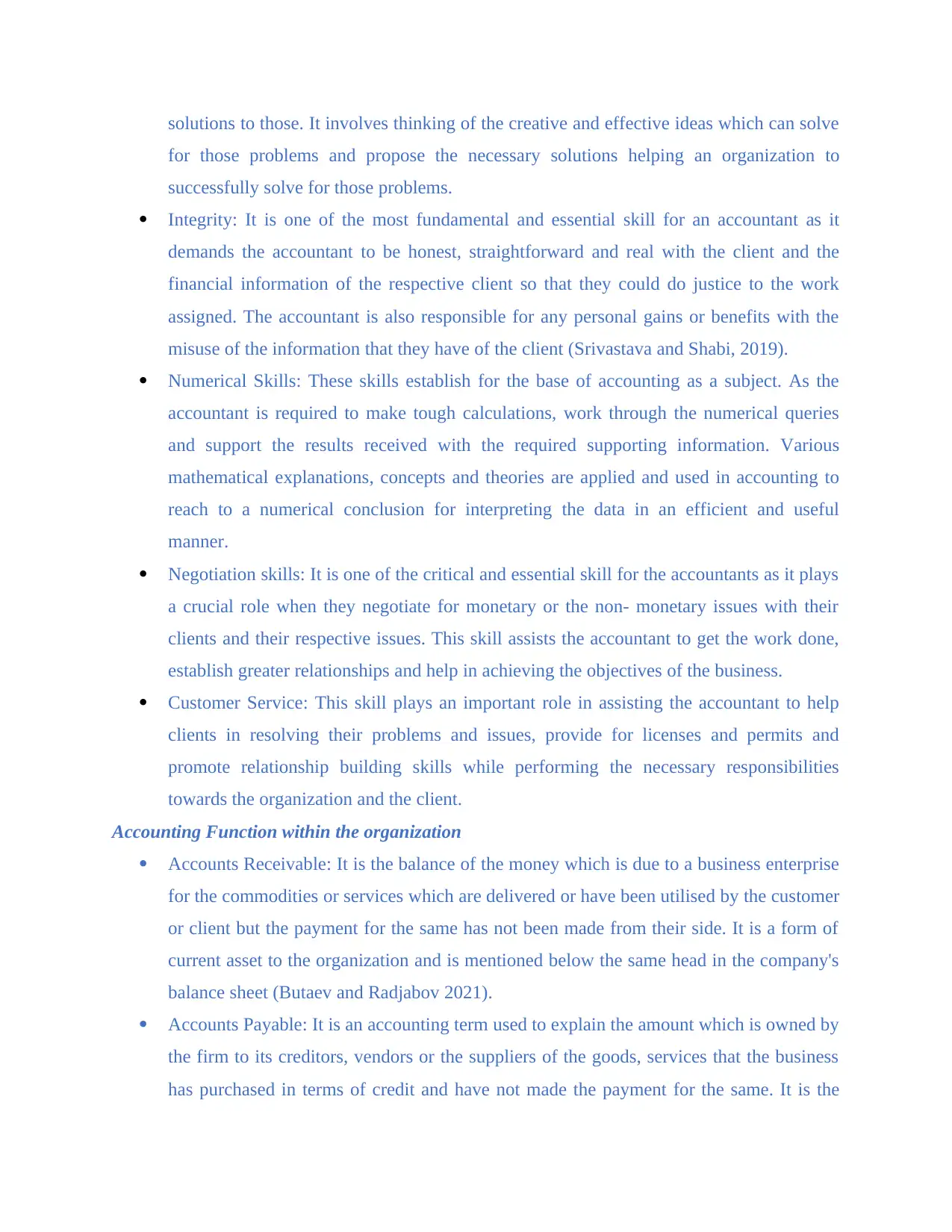
solutions to those. It involves thinking of the creative and effective ideas which can solve
for those problems and propose the necessary solutions helping an organization to
successfully solve for those problems.
Integrity: It is one of the most fundamental and essential skill for an accountant as it
demands the accountant to be honest, straightforward and real with the client and the
financial information of the respective client so that they could do justice to the work
assigned. The accountant is also responsible for any personal gains or benefits with the
misuse of the information that they have of the client (Srivastava and Shabi, 2019).
Numerical Skills: These skills establish for the base of accounting as a subject. As the
accountant is required to make tough calculations, work through the numerical queries
and support the results received with the required supporting information. Various
mathematical explanations, concepts and theories are applied and used in accounting to
reach to a numerical conclusion for interpreting the data in an efficient and useful
manner.
Negotiation skills: It is one of the critical and essential skill for the accountants as it plays
a crucial role when they negotiate for monetary or the non- monetary issues with their
clients and their respective issues. This skill assists the accountant to get the work done,
establish greater relationships and help in achieving the objectives of the business.
Customer Service: This skill plays an important role in assisting the accountant to help
clients in resolving their problems and issues, provide for licenses and permits and
promote relationship building skills while performing the necessary responsibilities
towards the organization and the client.
Accounting Function within the organization
Accounts Receivable: It is the balance of the money which is due to a business enterprise
for the commodities or services which are delivered or have been utilised by the customer
or client but the payment for the same has not been made from their side. It is a form of
current asset to the organization and is mentioned below the same head in the company's
balance sheet (Butaev and Radjabov 2021).
Accounts Payable: It is an accounting term used to explain the amount which is owned by
the firm to its creditors, vendors or the suppliers of the goods, services that the business
has purchased in terms of credit and have not made the payment for the same. It is the
for those problems and propose the necessary solutions helping an organization to
successfully solve for those problems.
Integrity: It is one of the most fundamental and essential skill for an accountant as it
demands the accountant to be honest, straightforward and real with the client and the
financial information of the respective client so that they could do justice to the work
assigned. The accountant is also responsible for any personal gains or benefits with the
misuse of the information that they have of the client (Srivastava and Shabi, 2019).
Numerical Skills: These skills establish for the base of accounting as a subject. As the
accountant is required to make tough calculations, work through the numerical queries
and support the results received with the required supporting information. Various
mathematical explanations, concepts and theories are applied and used in accounting to
reach to a numerical conclusion for interpreting the data in an efficient and useful
manner.
Negotiation skills: It is one of the critical and essential skill for the accountants as it plays
a crucial role when they negotiate for monetary or the non- monetary issues with their
clients and their respective issues. This skill assists the accountant to get the work done,
establish greater relationships and help in achieving the objectives of the business.
Customer Service: This skill plays an important role in assisting the accountant to help
clients in resolving their problems and issues, provide for licenses and permits and
promote relationship building skills while performing the necessary responsibilities
towards the organization and the client.
Accounting Function within the organization
Accounts Receivable: It is the balance of the money which is due to a business enterprise
for the commodities or services which are delivered or have been utilised by the customer
or client but the payment for the same has not been made from their side. It is a form of
current asset to the organization and is mentioned below the same head in the company's
balance sheet (Butaev and Radjabov 2021).
Accounts Payable: It is an accounting term used to explain the amount which is owned by
the firm to its creditors, vendors or the suppliers of the goods, services that the business
has purchased in terms of credit and have not made the payment for the same. It is the
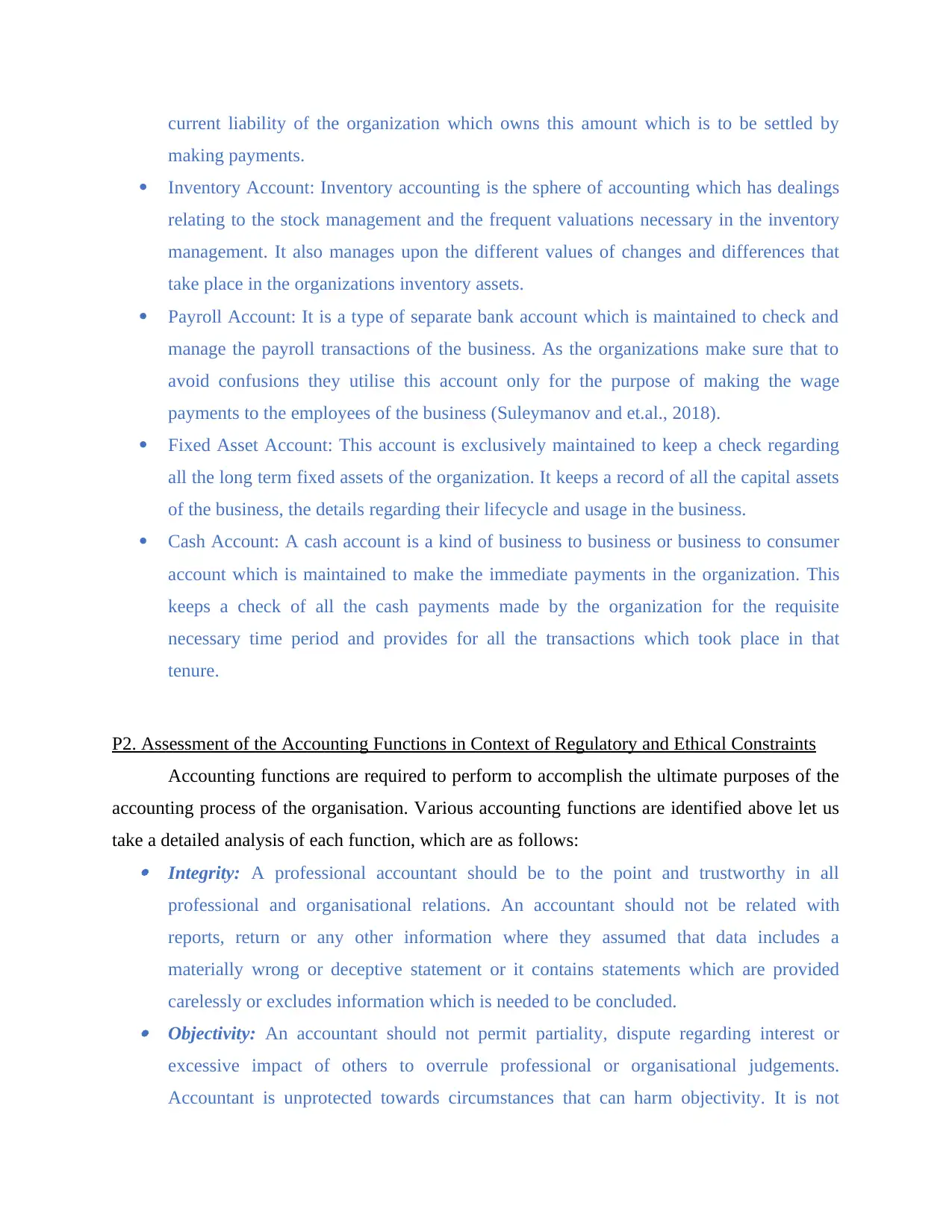
current liability of the organization which owns this amount which is to be settled by
making payments.
Inventory Account: Inventory accounting is the sphere of accounting which has dealings
relating to the stock management and the frequent valuations necessary in the inventory
management. It also manages upon the different values of changes and differences that
take place in the organizations inventory assets.
Payroll Account: It is a type of separate bank account which is maintained to check and
manage the payroll transactions of the business. As the organizations make sure that to
avoid confusions they utilise this account only for the purpose of making the wage
payments to the employees of the business (Suleymanov and et.al., 2018).
Fixed Asset Account: This account is exclusively maintained to keep a check regarding
all the long term fixed assets of the organization. It keeps a record of all the capital assets
of the business, the details regarding their lifecycle and usage in the business.
Cash Account: A cash account is a kind of business to business or business to consumer
account which is maintained to make the immediate payments in the organization. This
keeps a check of all the cash payments made by the organization for the requisite
necessary time period and provides for all the transactions which took place in that
tenure.
P2. Assessment of the Accounting Functions in Context of Regulatory and Ethical Constraints
Accounting functions are required to perform to accomplish the ultimate purposes of the
accounting process of the organisation. Various accounting functions are identified above let us
take a detailed analysis of each function, which are as follows: Integrity: A professional accountant should be to the point and trustworthy in all
professional and organisational relations. An accountant should not be related with
reports, return or any other information where they assumed that data includes a
materially wrong or deceptive statement or it contains statements which are provided
carelessly or excludes information which is needed to be concluded. Objectivity: An accountant should not permit partiality, dispute regarding interest or
excessive impact of others to overrule professional or organisational judgements.
Accountant is unprotected towards circumstances that can harm objectivity. It is not
making payments.
Inventory Account: Inventory accounting is the sphere of accounting which has dealings
relating to the stock management and the frequent valuations necessary in the inventory
management. It also manages upon the different values of changes and differences that
take place in the organizations inventory assets.
Payroll Account: It is a type of separate bank account which is maintained to check and
manage the payroll transactions of the business. As the organizations make sure that to
avoid confusions they utilise this account only for the purpose of making the wage
payments to the employees of the business (Suleymanov and et.al., 2018).
Fixed Asset Account: This account is exclusively maintained to keep a check regarding
all the long term fixed assets of the organization. It keeps a record of all the capital assets
of the business, the details regarding their lifecycle and usage in the business.
Cash Account: A cash account is a kind of business to business or business to consumer
account which is maintained to make the immediate payments in the organization. This
keeps a check of all the cash payments made by the organization for the requisite
necessary time period and provides for all the transactions which took place in that
tenure.
P2. Assessment of the Accounting Functions in Context of Regulatory and Ethical Constraints
Accounting functions are required to perform to accomplish the ultimate purposes of the
accounting process of the organisation. Various accounting functions are identified above let us
take a detailed analysis of each function, which are as follows: Integrity: A professional accountant should be to the point and trustworthy in all
professional and organisational relations. An accountant should not be related with
reports, return or any other information where they assumed that data includes a
materially wrong or deceptive statement or it contains statements which are provided
carelessly or excludes information which is needed to be concluded. Objectivity: An accountant should not permit partiality, dispute regarding interest or
excessive impact of others to overrule professional or organisational judgements.
Accountant is unprotected towards circumstances that can harm objectivity. It is not
⊘ This is a preview!⊘
Do you want full access?
Subscribe today to unlock all pages.

Trusted by 1+ million students worldwide
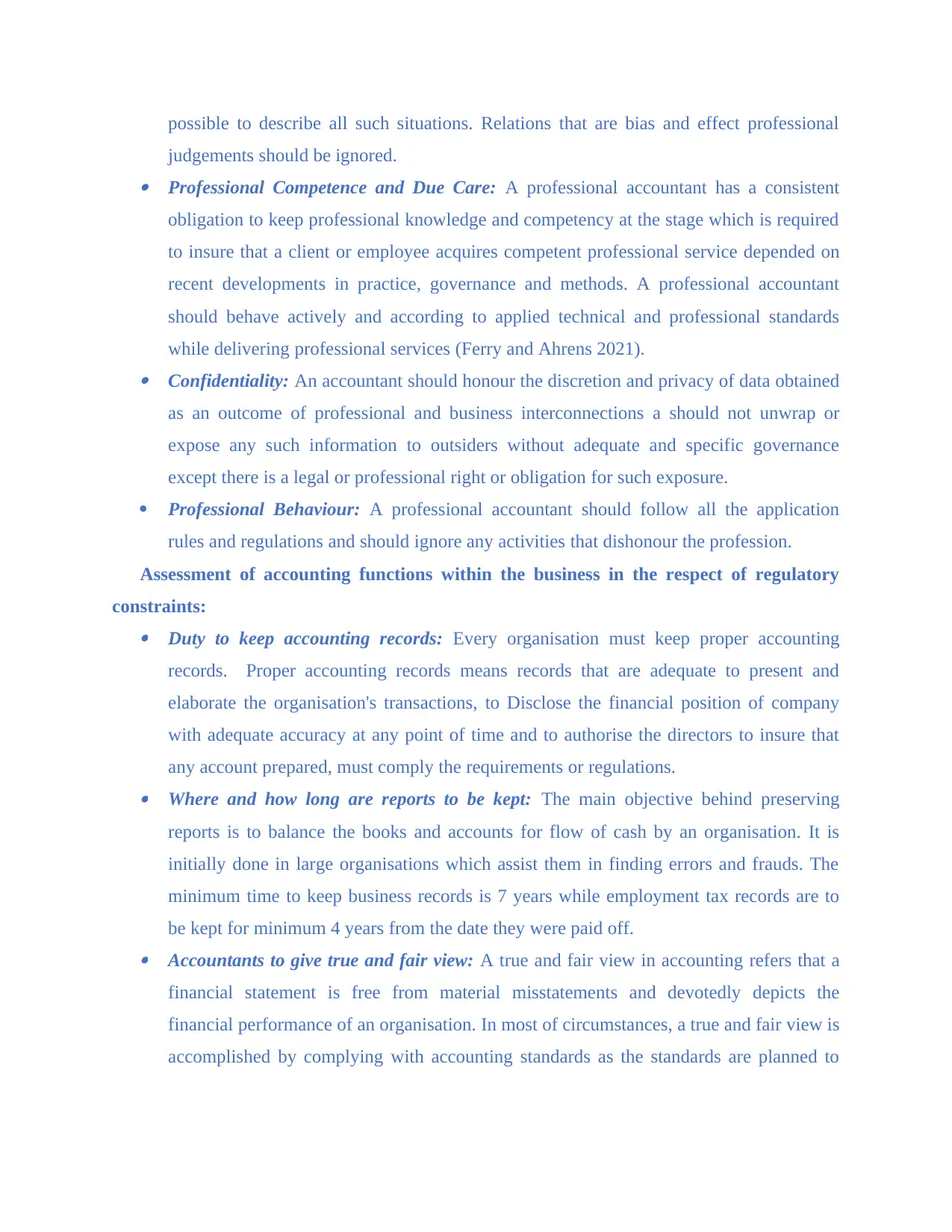
possible to describe all such situations. Relations that are bias and effect professional
judgements should be ignored. Professional Competence and Due Care: A professional accountant has a consistent
obligation to keep professional knowledge and competency at the stage which is required
to insure that a client or employee acquires competent professional service depended on
recent developments in practice, governance and methods. A professional accountant
should behave actively and according to applied technical and professional standards
while delivering professional services (Ferry and Ahrens 2021). Confidentiality: An accountant should honour the discretion and privacy of data obtained
as an outcome of professional and business interconnections a should not unwrap or
expose any such information to outsiders without adequate and specific governance
except there is a legal or professional right or obligation for such exposure.
Professional Behaviour: A professional accountant should follow all the application
rules and regulations and should ignore any activities that dishonour the profession.
Assessment of accounting functions within the business in the respect of regulatory
constraints: Duty to keep accounting records: Every organisation must keep proper accounting
records. Proper accounting records means records that are adequate to present and
elaborate the organisation's transactions, to Disclose the financial position of company
with adequate accuracy at any point of time and to authorise the directors to insure that
any account prepared, must comply the requirements or regulations. Where and how long are reports to be kept: The main objective behind preserving
reports is to balance the books and accounts for flow of cash by an organisation. It is
initially done in large organisations which assist them in finding errors and frauds. The
minimum time to keep business records is 7 years while employment tax records are to
be kept for minimum 4 years from the date they were paid off. Accountants to give true and fair view: A true and fair view in accounting refers that a
financial statement is free from material misstatements and devotedly depicts the
financial performance of an organisation. In most of circumstances, a true and fair view is
accomplished by complying with accounting standards as the standards are planned to
judgements should be ignored. Professional Competence and Due Care: A professional accountant has a consistent
obligation to keep professional knowledge and competency at the stage which is required
to insure that a client or employee acquires competent professional service depended on
recent developments in practice, governance and methods. A professional accountant
should behave actively and according to applied technical and professional standards
while delivering professional services (Ferry and Ahrens 2021). Confidentiality: An accountant should honour the discretion and privacy of data obtained
as an outcome of professional and business interconnections a should not unwrap or
expose any such information to outsiders without adequate and specific governance
except there is a legal or professional right or obligation for such exposure.
Professional Behaviour: A professional accountant should follow all the application
rules and regulations and should ignore any activities that dishonour the profession.
Assessment of accounting functions within the business in the respect of regulatory
constraints: Duty to keep accounting records: Every organisation must keep proper accounting
records. Proper accounting records means records that are adequate to present and
elaborate the organisation's transactions, to Disclose the financial position of company
with adequate accuracy at any point of time and to authorise the directors to insure that
any account prepared, must comply the requirements or regulations. Where and how long are reports to be kept: The main objective behind preserving
reports is to balance the books and accounts for flow of cash by an organisation. It is
initially done in large organisations which assist them in finding errors and frauds. The
minimum time to keep business records is 7 years while employment tax records are to
be kept for minimum 4 years from the date they were paid off. Accountants to give true and fair view: A true and fair view in accounting refers that a
financial statement is free from material misstatements and devotedly depicts the
financial performance of an organisation. In most of circumstances, a true and fair view is
accomplished by complying with accounting standards as the standards are planned to
Paraphrase This Document
Need a fresh take? Get an instant paraphrase of this document with our AI Paraphraser
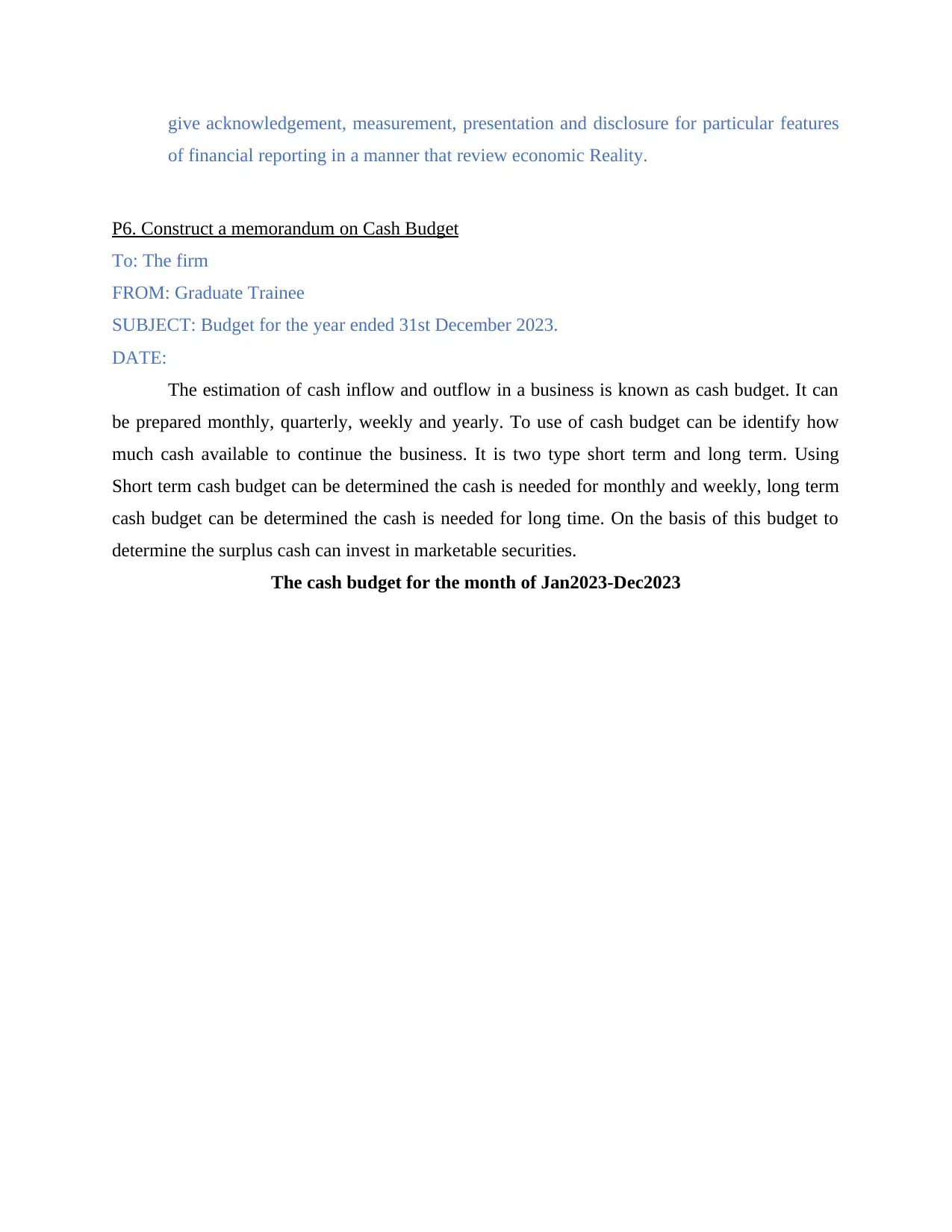
give acknowledgement, measurement, presentation and disclosure for particular features
of financial reporting in a manner that review economic Reality.
P6. Construct a memorandum on Cash Budget
To: The firm
FROM: Graduate Trainee
SUBJECT: Budget for the year ended 31st December 2023.
DATE:
The estimation of cash inflow and outflow in a business is known as cash budget. It can
be prepared monthly, quarterly, weekly and yearly. To use of cash budget can be identify how
much cash available to continue the business. It is two type short term and long term. Using
Short term cash budget can be determined the cash is needed for monthly and weekly, long term
cash budget can be determined the cash is needed for long time. On the basis of this budget to
determine the surplus cash can invest in marketable securities.
The cash budget for the month of Jan2023-Dec2023
of financial reporting in a manner that review economic Reality.
P6. Construct a memorandum on Cash Budget
To: The firm
FROM: Graduate Trainee
SUBJECT: Budget for the year ended 31st December 2023.
DATE:
The estimation of cash inflow and outflow in a business is known as cash budget. It can
be prepared monthly, quarterly, weekly and yearly. To use of cash budget can be identify how
much cash available to continue the business. It is two type short term and long term. Using
Short term cash budget can be determined the cash is needed for monthly and weekly, long term
cash budget can be determined the cash is needed for long time. On the basis of this budget to
determine the surplus cash can invest in marketable securities.
The cash budget for the month of Jan2023-Dec2023
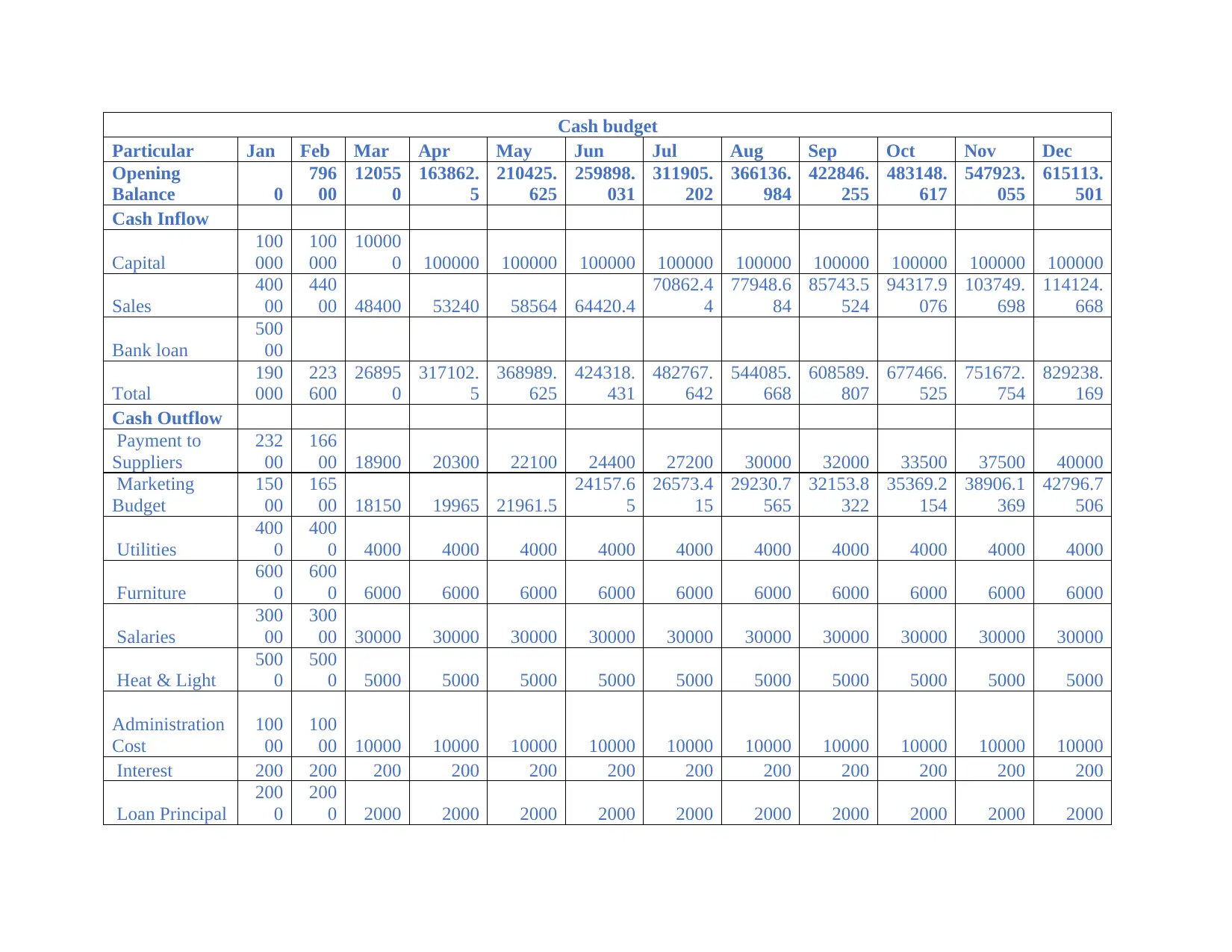
Cash budget
Particular Jan Feb Mar Apr May Jun Jul Aug Sep Oct Nov Dec
Opening
Balance 0
796
00
12055
0
163862.
5
210425.
625
259898.
031
311905.
202
366136.
984
422846.
255
483148.
617
547923.
055
615113.
501
Cash Inflow
Capital
100
000
100
000
10000
0 100000 100000 100000 100000 100000 100000 100000 100000 100000
Sales
400
00
440
00 48400 53240 58564 64420.4
70862.4
4
77948.6
84
85743.5
524
94317.9
076
103749.
698
114124.
668
Bank loan
500
00
Total
190
000
223
600
26895
0
317102.
5
368989.
625
424318.
431
482767.
642
544085.
668
608589.
807
677466.
525
751672.
754
829238.
169
Cash Outflow
Payment to
Suppliers
232
00
166
00 18900 20300 22100 24400 27200 30000 32000 33500 37500 40000
Marketing
Budget
150
00
165
00 18150 19965 21961.5
24157.6
5
26573.4
15
29230.7
565
32153.8
322
35369.2
154
38906.1
369
42796.7
506
Utilities
400
0
400
0 4000 4000 4000 4000 4000 4000 4000 4000 4000 4000
Furniture
600
0
600
0 6000 6000 6000 6000 6000 6000 6000 6000 6000 6000
Salaries
300
00
300
00 30000 30000 30000 30000 30000 30000 30000 30000 30000 30000
Heat & Light
500
0
500
0 5000 5000 5000 5000 5000 5000 5000 5000 5000 5000
Administration
Cost
100
00
100
00 10000 10000 10000 10000 10000 10000 10000 10000 10000 10000
Interest 200 200 200 200 200 200 200 200 200 200 200 200
Loan Principal
200
0
200
0 2000 2000 2000 2000 2000 2000 2000 2000 2000 2000
Particular Jan Feb Mar Apr May Jun Jul Aug Sep Oct Nov Dec
Opening
Balance 0
796
00
12055
0
163862.
5
210425.
625
259898.
031
311905.
202
366136.
984
422846.
255
483148.
617
547923.
055
615113.
501
Cash Inflow
Capital
100
000
100
000
10000
0 100000 100000 100000 100000 100000 100000 100000 100000 100000
Sales
400
00
440
00 48400 53240 58564 64420.4
70862.4
4
77948.6
84
85743.5
524
94317.9
076
103749.
698
114124.
668
Bank loan
500
00
Total
190
000
223
600
26895
0
317102.
5
368989.
625
424318.
431
482767.
642
544085.
668
608589.
807
677466.
525
751672.
754
829238.
169
Cash Outflow
Payment to
Suppliers
232
00
166
00 18900 20300 22100 24400 27200 30000 32000 33500 37500 40000
Marketing
Budget
150
00
165
00 18150 19965 21961.5
24157.6
5
26573.4
15
29230.7
565
32153.8
322
35369.2
154
38906.1
369
42796.7
506
Utilities
400
0
400
0 4000 4000 4000 4000 4000 4000 4000 4000 4000 4000
Furniture
600
0
600
0 6000 6000 6000 6000 6000 6000 6000 6000 6000 6000
Salaries
300
00
300
00 30000 30000 30000 30000 30000 30000 30000 30000 30000 30000
Heat & Light
500
0
500
0 5000 5000 5000 5000 5000 5000 5000 5000 5000 5000
Administration
Cost
100
00
100
00 10000 10000 10000 10000 10000 10000 10000 10000 10000 10000
Interest 200 200 200 200 200 200 200 200 200 200 200 200
Loan Principal
200
0
200
0 2000 2000 2000 2000 2000 2000 2000 2000 2000 2000
⊘ This is a preview!⊘
Do you want full access?
Subscribe today to unlock all pages.

Trusted by 1+ million students worldwide
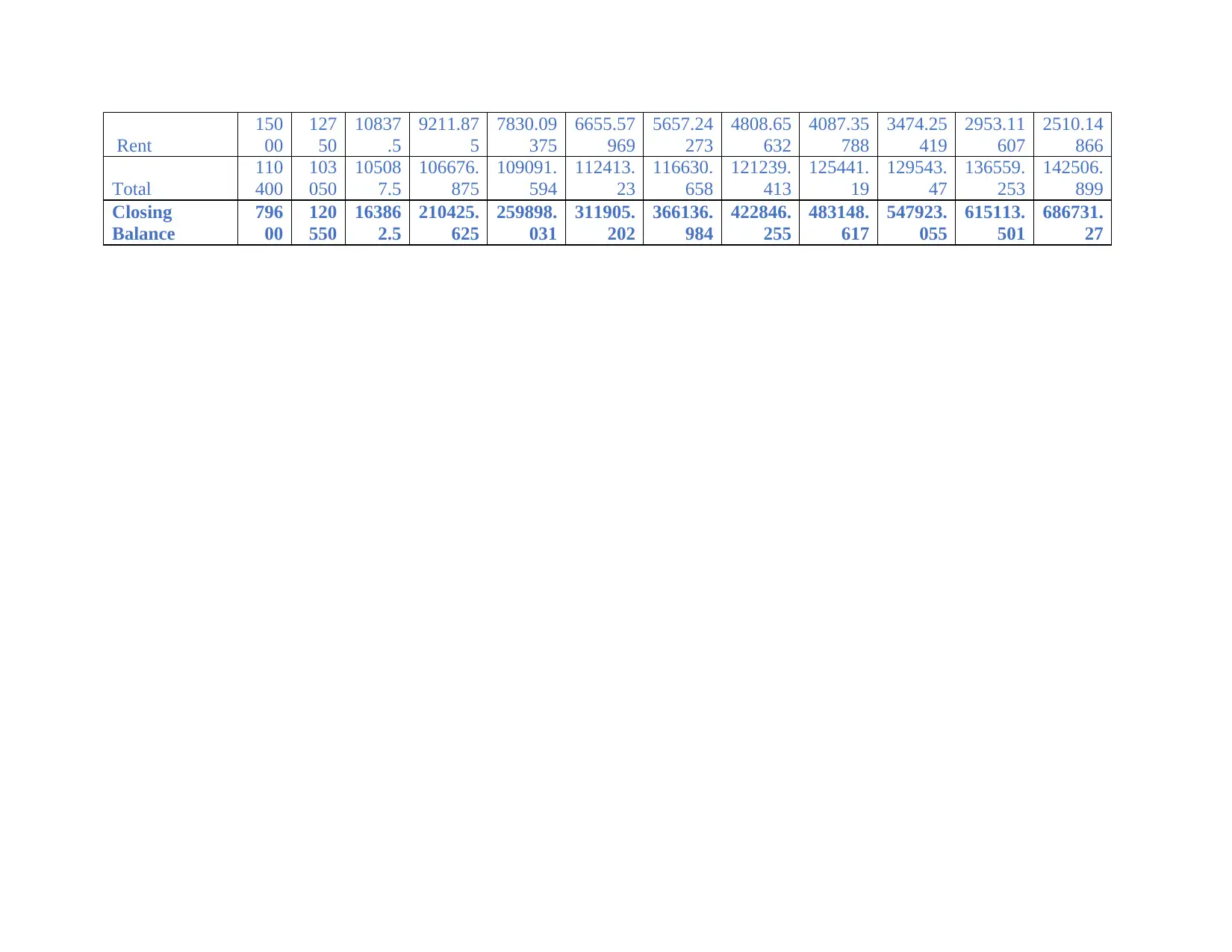
Rent
150
00
127
50
10837
.5
9211.87
5
7830.09
375
6655.57
969
5657.24
273
4808.65
632
4087.35
788
3474.25
419
2953.11
607
2510.14
866
Total
110
400
103
050
10508
7.5
106676.
875
109091.
594
112413.
23
116630.
658
121239.
413
125441.
19
129543.
47
136559.
253
142506.
899
Closing
Balance
796
00
120
550
16386
2.5
210425.
625
259898.
031
311905.
202
366136.
984
422846.
255
483148.
617
547923.
055
615113.
501
686731.
27
150
00
127
50
10837
.5
9211.87
5
7830.09
375
6655.57
969
5657.24
273
4808.65
632
4087.35
788
3474.25
419
2953.11
607
2510.14
866
Total
110
400
103
050
10508
7.5
106676.
875
109091.
594
112413.
23
116630.
658
121239.
413
125441.
19
129543.
47
136559.
253
142506.
899
Closing
Balance
796
00
120
550
16386
2.5
210425.
625
259898.
031
311905.
202
366136.
984
422846.
255
483148.
617
547923.
055
615113.
501
686731.
27
Paraphrase This Document
Need a fresh take? Get an instant paraphrase of this document with our AI Paraphraser
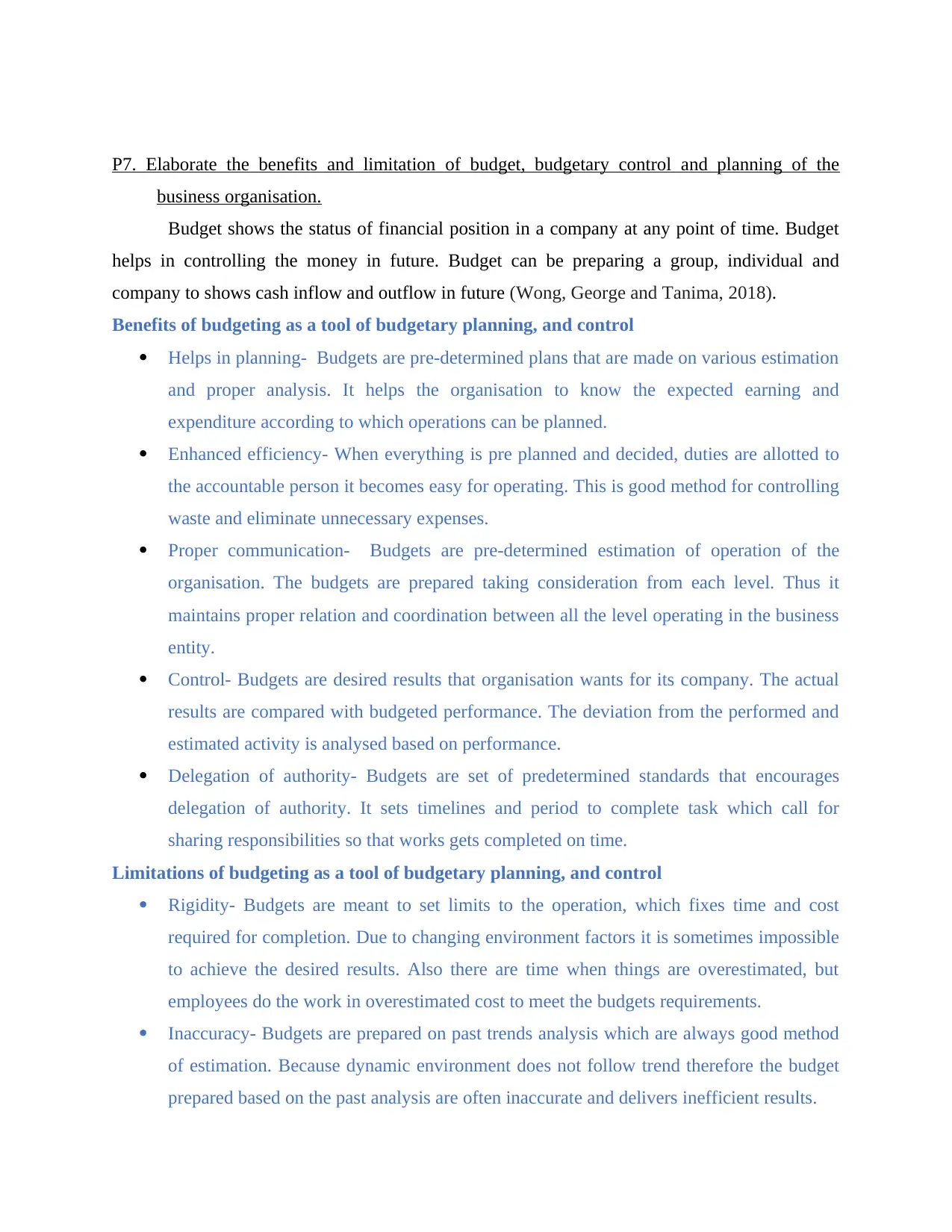
P7. Elaborate the benefits and limitation of budget, budgetary control and planning of the
business organisation.
Budget shows the status of financial position in a company at any point of time. Budget
helps in controlling the money in future. Budget can be preparing a group, individual and
company to shows cash inflow and outflow in future (Wong, George and Tanima, 2018).
Benefits of budgeting as a tool of budgetary planning, and control
Helps in planning- Budgets are pre-determined plans that are made on various estimation
and proper analysis. It helps the organisation to know the expected earning and
expenditure according to which operations can be planned.
Enhanced efficiency- When everything is pre planned and decided, duties are allotted to
the accountable person it becomes easy for operating. This is good method for controlling
waste and eliminate unnecessary expenses.
Proper communication- Budgets are pre-determined estimation of operation of the
organisation. The budgets are prepared taking consideration from each level. Thus it
maintains proper relation and coordination between all the level operating in the business
entity.
Control- Budgets are desired results that organisation wants for its company. The actual
results are compared with budgeted performance. The deviation from the performed and
estimated activity is analysed based on performance.
Delegation of authority- Budgets are set of predetermined standards that encourages
delegation of authority. It sets timelines and period to complete task which call for
sharing responsibilities so that works gets completed on time.
Limitations of budgeting as a tool of budgetary planning, and control
Rigidity- Budgets are meant to set limits to the operation, which fixes time and cost
required for completion. Due to changing environment factors it is sometimes impossible
to achieve the desired results. Also there are time when things are overestimated, but
employees do the work in overestimated cost to meet the budgets requirements.
Inaccuracy- Budgets are prepared on past trends analysis which are always good method
of estimation. Because dynamic environment does not follow trend therefore the budget
prepared based on the past analysis are often inaccurate and delivers inefficient results.
business organisation.
Budget shows the status of financial position in a company at any point of time. Budget
helps in controlling the money in future. Budget can be preparing a group, individual and
company to shows cash inflow and outflow in future (Wong, George and Tanima, 2018).
Benefits of budgeting as a tool of budgetary planning, and control
Helps in planning- Budgets are pre-determined plans that are made on various estimation
and proper analysis. It helps the organisation to know the expected earning and
expenditure according to which operations can be planned.
Enhanced efficiency- When everything is pre planned and decided, duties are allotted to
the accountable person it becomes easy for operating. This is good method for controlling
waste and eliminate unnecessary expenses.
Proper communication- Budgets are pre-determined estimation of operation of the
organisation. The budgets are prepared taking consideration from each level. Thus it
maintains proper relation and coordination between all the level operating in the business
entity.
Control- Budgets are desired results that organisation wants for its company. The actual
results are compared with budgeted performance. The deviation from the performed and
estimated activity is analysed based on performance.
Delegation of authority- Budgets are set of predetermined standards that encourages
delegation of authority. It sets timelines and period to complete task which call for
sharing responsibilities so that works gets completed on time.
Limitations of budgeting as a tool of budgetary planning, and control
Rigidity- Budgets are meant to set limits to the operation, which fixes time and cost
required for completion. Due to changing environment factors it is sometimes impossible
to achieve the desired results. Also there are time when things are overestimated, but
employees do the work in overestimated cost to meet the budgets requirements.
Inaccuracy- Budgets are prepared on past trends analysis which are always good method
of estimation. Because dynamic environment does not follow trend therefore the budget
prepared based on the past analysis are often inaccurate and delivers inefficient results.
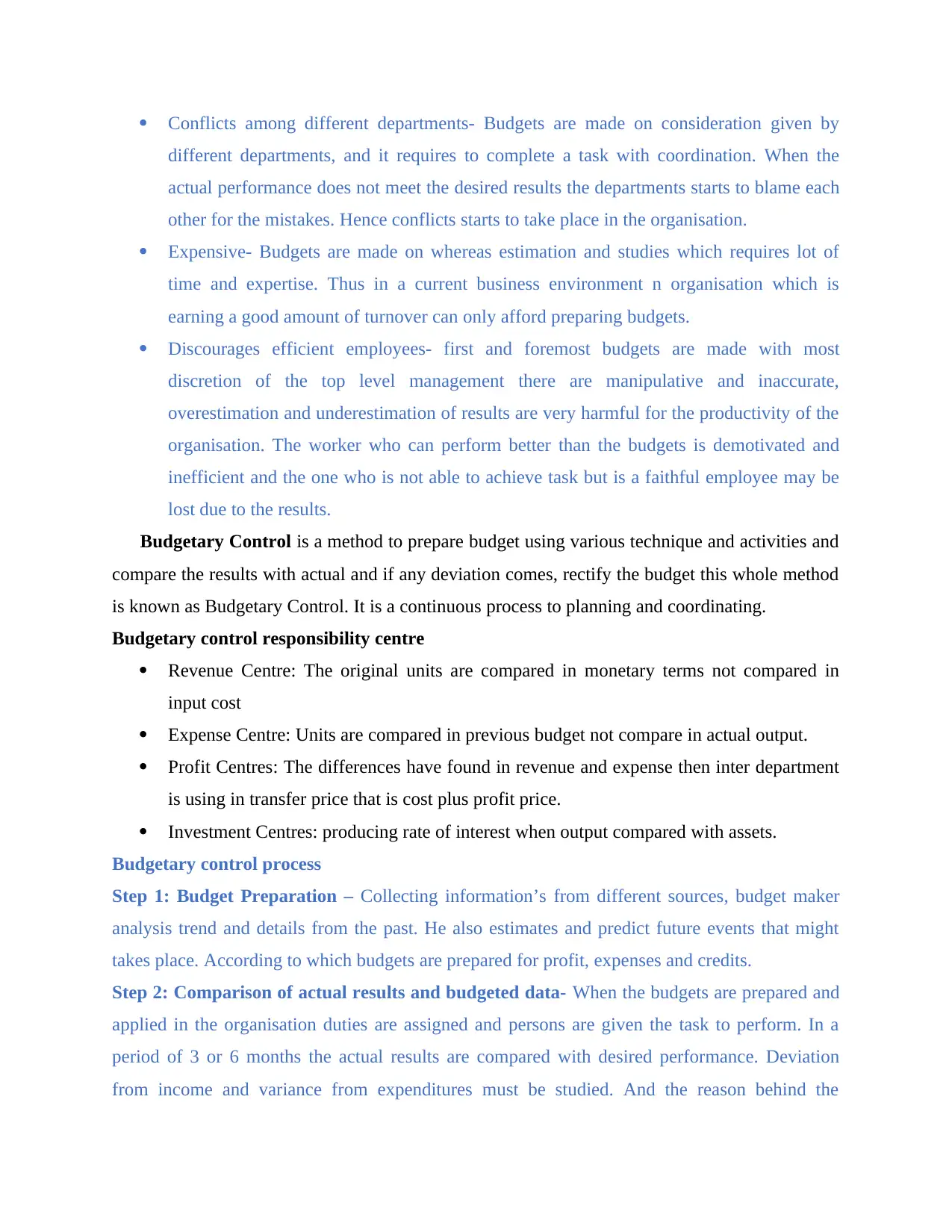
Conflicts among different departments- Budgets are made on consideration given by
different departments, and it requires to complete a task with coordination. When the
actual performance does not meet the desired results the departments starts to blame each
other for the mistakes. Hence conflicts starts to take place in the organisation.
Expensive- Budgets are made on whereas estimation and studies which requires lot of
time and expertise. Thus in a current business environment n organisation which is
earning a good amount of turnover can only afford preparing budgets.
Discourages efficient employees- first and foremost budgets are made with most
discretion of the top level management there are manipulative and inaccurate,
overestimation and underestimation of results are very harmful for the productivity of the
organisation. The worker who can perform better than the budgets is demotivated and
inefficient and the one who is not able to achieve task but is a faithful employee may be
lost due to the results.
Budgetary Control is a method to prepare budget using various technique and activities and
compare the results with actual and if any deviation comes, rectify the budget this whole method
is known as Budgetary Control. It is a continuous process to planning and coordinating.
Budgetary control responsibility centre
Revenue Centre: The original units are compared in monetary terms not compared in
input cost
Expense Centre: Units are compared in previous budget not compare in actual output.
Profit Centres: The differences have found in revenue and expense then inter department
is using in transfer price that is cost plus profit price.
Investment Centres: producing rate of interest when output compared with assets.
Budgetary control process
Step 1: Budget Preparation – Collecting information’s from different sources, budget maker
analysis trend and details from the past. He also estimates and predict future events that might
takes place. According to which budgets are prepared for profit, expenses and credits.
Step 2: Comparison of actual results and budgeted data- When the budgets are prepared and
applied in the organisation duties are assigned and persons are given the task to perform. In a
period of 3 or 6 months the actual results are compared with desired performance. Deviation
from income and variance from expenditures must be studied. And the reason behind the
different departments, and it requires to complete a task with coordination. When the
actual performance does not meet the desired results the departments starts to blame each
other for the mistakes. Hence conflicts starts to take place in the organisation.
Expensive- Budgets are made on whereas estimation and studies which requires lot of
time and expertise. Thus in a current business environment n organisation which is
earning a good amount of turnover can only afford preparing budgets.
Discourages efficient employees- first and foremost budgets are made with most
discretion of the top level management there are manipulative and inaccurate,
overestimation and underestimation of results are very harmful for the productivity of the
organisation. The worker who can perform better than the budgets is demotivated and
inefficient and the one who is not able to achieve task but is a faithful employee may be
lost due to the results.
Budgetary Control is a method to prepare budget using various technique and activities and
compare the results with actual and if any deviation comes, rectify the budget this whole method
is known as Budgetary Control. It is a continuous process to planning and coordinating.
Budgetary control responsibility centre
Revenue Centre: The original units are compared in monetary terms not compared in
input cost
Expense Centre: Units are compared in previous budget not compare in actual output.
Profit Centres: The differences have found in revenue and expense then inter department
is using in transfer price that is cost plus profit price.
Investment Centres: producing rate of interest when output compared with assets.
Budgetary control process
Step 1: Budget Preparation – Collecting information’s from different sources, budget maker
analysis trend and details from the past. He also estimates and predict future events that might
takes place. According to which budgets are prepared for profit, expenses and credits.
Step 2: Comparison of actual results and budgeted data- When the budgets are prepared and
applied in the organisation duties are assigned and persons are given the task to perform. In a
period of 3 or 6 months the actual results are compared with desired performance. Deviation
from income and variance from expenditures must be studied. And the reason behind the
⊘ This is a preview!⊘
Do you want full access?
Subscribe today to unlock all pages.

Trusted by 1+ million students worldwide
1 out of 26
Related Documents
Your All-in-One AI-Powered Toolkit for Academic Success.
+13062052269
info@desklib.com
Available 24*7 on WhatsApp / Email
![[object Object]](/_next/static/media/star-bottom.7253800d.svg)
Unlock your academic potential
Copyright © 2020–2025 A2Z Services. All Rights Reserved. Developed and managed by ZUCOL.





